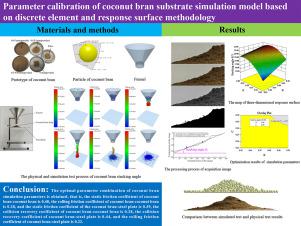Powder Technology ( IF 5.2 ) Pub Date : 2021-09-24 , DOI: 10.1016/j.powtec.2021.09.065 Liang Zhao 1 , Hongping Zhou 1 , Linyun Xu 1 , Shiyu Song 1 , Chao Zhang 1 , Qingxu Yu 2

|
In order to improve the accuracy of the parameters used in discrete element simulation study of coconut bran, physical and simulation experiments were combined to calibrate discrete element simulation parameters of the species. First, the intrinsic parameters and actual stacking angle of coconut bran were measured through physical tests. Next, the simulated stacking angle was used as the response value, Plackett-Burman test was designed with Design-Expert software, and the parameters that had a significant impact on the stacking angle were identified and selected. The results of the screening test show that the static friction coefficient of coconut bran-coconut bran, the rolling friction coefficient of coconut bran-coconut bran and the static friction coefficient of coconut bran-steel plate have significant effects on the stacking angle. The relative error of the stacking angle was taken as the evaluation index, the steepest climbing test was performed on the three significant parameters, the value range of the significance parameter was optimized, and Box-Behnken test was adopted to establish the quadratic regression model between the stacking angle and significance parameters based on response surface methodology (RSM). the stacking angle of 20.08° measured by the physical experiment was taken as the target value in the model, and the regression equation was optimized to obtain the optimal combination of parameters: 0.48 for the static friction coefficient of coconut bran-coconut bran, 0.28 for the rolling friction coefficient of coconut bran-coconut bran, and 0.39 for the static friction coefficient of coconut bran-steel plate. Finally, the verification tests on the stacking angle and fluidity of coconut bran were carried out, and the results show the average relative errors of the two tests are small, which verify the reliability of the calibration results and research methods of coconut bran simulation parameters. The research results show the calibrated parameters can provide references for the selection of coconut bran discrete element simulation parameters and the design and optimization of related equipment.
中文翻译:

基于离散元和响应面法的椰糠基质仿真模型参数标定
为提高椰糠离散元模拟研究中参数的准确性,结合物理和模拟实验对品种离散元模拟参数进行标定。首先,通过物理测试测量了椰糠的内在参数和实际堆积角度。接下来,以模拟堆积角为响应值,利用Design-Expert软件设计Plackett-Burman检验,识别和选择对堆积角有显着影响的参数。筛选试验结果表明,椰糠-椰糠的静摩擦系数、椰糠-椰糠的滚动摩擦系数和椰糠-钢板的静摩擦系数对堆积角有显着影响。以堆垛角的相对误差为评价指标,对三个显着参数进行最陡爬坡试验,优化显着参数取值范围,采用Box-Behnken检验建立三项间的二次回归模型。基于响应面方法 (RSM) 的叠加角和显着性参数。模型中以物理实验测得的堆积角20.08°为目标值,对回归方程进行优化,得到最佳参数组合:椰糠-椰糠静摩擦系数为0.48,椰糠静摩擦系数为0.28椰糠-椰糠的滚动摩擦系数,椰糠-钢板的静摩擦系数为0.39。最后,对椰糠的堆积角和流动性进行了验证试验,结果表明,两次试验的平均相对误差较小,验证了椰糠模拟参数标定结果和研究方法的可靠性。研究结果表明,标定后的参数可为椰糠离散元仿真参数的选取及相关设备的设计优化提供参考。



























 京公网安备 11010802027423号
京公网安备 11010802027423号